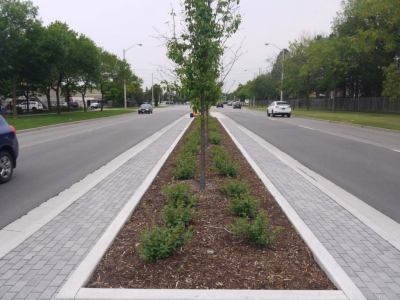Stormwater Tree Trenches: Maintenance
Revision as of 20:21, 23 February 2022 by DanielFilippi (talk | contribs)
The following maintenance procedures and preventative measures should be incorporated into a maintenance plan:

An example of a stormwater tree trench system located within the existing street median, Mississauga, ON. Central Parkway retrofit. (Source: STEP, 2016).[1]
- Tree Maintenance: Inspection and maintenance of all municipally-owned trees shall be conducted by municipal staff or its contractors after the warranty period of the construction contract. This work may include, frequent watering and fertilizing as trees begin to establish themselves in the feature, this is especially important during drought-like conditions. Proper tree pruning is also important throughout the life of the tree, but especially during the early life stages of trees to help limit the potential for detrimental deformations or growth habits. This will help reduce costs as the tree matures and attempts at correcting improper growth, or replacement of the tree entirely becomes more costly. Staff involved in inspection and maintenance of these features should be experienced with the designated planting plan, plant species identification, and weed removal and control methodologies enacted by the municipality.
- Inlet Structures: Drainage pipes and structures within or draining to the subsurface bedding beneath porous pavement should be cleaned out on regular intervals .[2]
- Heavy Vehicles: Trucks and other heavy vehicles can ground dirt into the porous surface and lead to clogging. These vehicles should be prevented from tracking or spilling dirt onto the pavement. Signage and training of facilities personnel is suggested. .[2]
- Construction and Hazardous Materials: Due to the potential for groundwater contamination, all construction or hazardous material carriers should be prohibited from entering a permeable pavement site.[2]
- Drainage Areas: Impervious areas contributing to the permeable pavement should be regularly swept and kept clear of litter and debris.Flows from any landscaped areas should be diverted away from the pavement or at least be well stabilized with vegetation.
- Grid Pavers: Paver or grid systems that have been planted with grass should be mowed regularly and the clippings should be removed. Water and fertilize as needed. .[2]
- Seal Coating: Seal coats should never be applied to permeable pavements. Current and future owners and operations staff must be aware of permeable pavement areas and the importance of not applying any sealants. Porous asphalt and pervious concrete look very similar to their impervious versions and could be inadvertently sealed over.
- Potholes: For porous asphalt or pervious concrete, isolated potholes can be patched with standard patching mixes. Patching can continue until the structural integrity of the pavement has been compromised or stormwater can no longer drain to the aggregate base. Then the surface will need to be torn up and replaced.
- Uneven Pavers: An uneven paver surface can be repaired by pulling up the pavers, redistributing the bedding layer, and then placing the pavers back. New filler stone will need to be swept into the replaced pavers. Typically the pavers are packed very tightly, and breaking one or more pavers will be necessary to pull up a group of pavers. Keeping a set of replacement pavers after construction will be useful for making future repairs.
- Weeds: Over time, weed growth may become an aesthetic problem, particularly on surfaces with infrequent traffic. Keeping the pavement surface free of organic material through regular sweeping and vacuuming can impede weeds from taking root. Ontario has banned the use of cosmetic herbicides for weed control.
- Vacuuming: Annual vacuuming of permeable interlocking concrete pavers can increase the operational lifespan of these pavers. [3]
- Winter Maintenance: Sand should not be spread on permeable pavement as it can quickly lead to clogging. Deicers should only be used in moderation and only when needed because dissolved constituents are not removed by the pavement system. Pilot studies at the University of New Hampshire Stormwater Center have found that permeable pavement requires 75% less salt than conventional pavement over the course of a typical winter season. [4]
- Snow Plowing: Permeable pavement is plowed for snow removal like any other pavement. When groundwater contamination from chlorides is a concern, plowed snow piles and snow melt should not be directed to permeable paver and porous pavement systems[5]
Also, plowed snow/snow piles should not be stored on top of permeable pavements, since this snow often contains granular materials which can contribute to clogging
Annual inspections of permeable pavement should be conducted in the spring prior to onset of the summer thunderstorm season. These inspections should check for evidence of spills and surface ponding (staining or sediment accumulation on pavement surface), damage and deterioration.
For more detailed guidance, refer to STEP's Low Impact Development Stormwater Management Practice Inspection and Maintenance Guide and Permeable Pavements Inspection and Maintenance Fact Sheet, both of which can be accessed here
- ↑ https://cvc.ca/wp-content/uploads//2021/07/TechReport_CPW_Final.pdf
- ↑ Jump up to: 2.0 2.1 2.2 2.3 Cite error: Invalid
<ref>tag; no text was provided for refs namedmanchester2002 - ↑ Jennifer Drake, Andrea Bradford, Tim Van Seters and Glenn MacMillan, 2016. Evaluation of Permeable Pavements in Cold Climates. accessed at https://sustainabletechnologies.ca/app/uploads/2013/02/KPP-Final-2012.pdf
- ↑ University of New Hampshire Stormwater Center (UNHSC). 2007. 2007 Annual Report. Durham, NH.
- ↑ Smith, D. 2006. Permeable Interlocking Concrete Pavements; Selection, Design, Construction, Maintenance. 3rd Edition. Interlocking Concrete Pavement Institute.Burlington, ON.